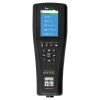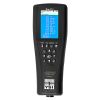YSI ProSwap 1-Port Cable Assemblies
Features
- Integrated temperature sensor with optional depth sensor
- Rugged twist-lock MS connector
- Includes probe guard and calibration/cleaning accessories
- Free ground shipping
- Expedited repair and warranty service
- Lifetime technical support
- More
Overview
ProSwap cables meet the needs of most water quality sampling applications with lengths ranging from 1 to 100 meters and 2.54 cm diameter. The ProSwap cable accommodates any single ProDSS digital smart sensor.
Digital Smart Sensor
Calibration information is saved in each smart sensor for an easy plug-and-play experience. Connect to a ProSwap or ProDSS handheld meter via the twist-lock MS connector to form a complete system. Options include:
- Conductivity/Temperature
- Optical Dissolved Oxygen
- pH
- PH/ORP
- Turbidity
- Total Algae-PC (Phycocyanin + Chlorophyll)
- Total Algae-PE (Phycoerythrin + Chlorophyll)
- Ammonium ISE
- Chloride ISE
- Nitrate ISE
Benefits
All ProSwap cables have a thermistor built-into the bulkhead for supplemental temperature readings and compensation. Additionally, an optional depth module is built-into the probe assembly. Cables include a non-reflective black plastic probe guard, storage sleeve, sponge, graduated cylinder for calibration, and maintenance kit (port plug, spare o-rings, tube of Krytox lubricant, syringe for depth sensor cleaning, and sensor installation/removal tool). A 4.9 oz weight and cable management kit is included with cables 4 meters and longer.
- (1) 1-port cable assembly with temperature sensor (depth sensor optional)
- (1) Black plastic probe guard
- (1) Storage sleeve
- (1) Sponge
- (1) Graduated cylinder for calibration
- (1) Maintenance kit (port plug, spare o-rings, tube of Krytox lubricant, syringe for depth sensor cleaning, and sensor installation/removal tool)
- (1) 4.9 oz weight and cable management kit (included with cables 4 meters and longer)
In The News
From Hurricanes to Florida’s Red Tides: Monitoring the Southwest Gulf Coast
Nearly every year, southwest Florida is blighted by harmful Karenia brevis blooms–known colloquially as Florida red tides. These harmful algal blooms (HABs) form over the West Florida shelf and are pushed shorewards by winds and currents. Once in touching distance of the coast, they often intensify, fed by land-based runoff, anthropogenic nutrients, and decomposing marine life killed by toxins produced by these red tides. Red tides have become more severe and persistent over the past 20 years, causing major environmental and economic damage.
Read MoreWave-Powered Buoy Deployed in Puget Sound
While the development of solar-powered monitoring systems has improved access to real-time environmental data, solar power is still limited by low light conditions, such as poor weather, nighttime, or high-latitude environments. To supplement these incumbent power solutions at sea, Ocean Motion Technologies has developed a small-scale ocean wave energy system that can be directly integrated with existing data buoy platforms. Not only does wave energy supplement solar power during periods when the buoys are limited by light availability, but it also allows data buoys to perform beyond their current power capacities.
Read MoreLong-Term Monitoring in the Chautauqua Lake Watershed
With a widely developed shoreline, Chautauqua Lake experiences influxes of non-point source pollution that have historically impacted the health of the lake. The Chautauqua Lake Association (CLA) has been monitoring the lake for over two decades, reporting on changes that have occurred over the years. A pair of local lake advocates, Jane and Doug Conroe, have lived on the lake for over 40 years and have played an important role in establishing monitoring programs and facilitating consistent data collection throughout the watershed. Doug has been involved with the Chautauqua Lake Association (CLA) since the pair moved to the area in 1980, and is currently serving as the Executive Director.
Read More

































